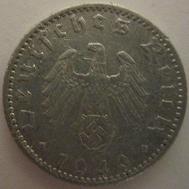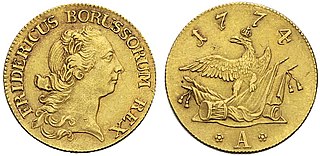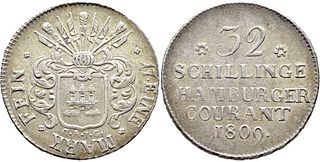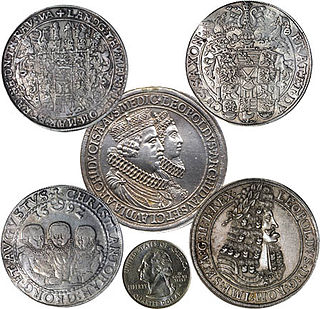 W
WThe zinc 5 Reichspfennig coin was minted by Nazi Germany between 1940 and 1944 during World War II, replacing the bronze-aluminum version, which had a distinct golden color. It was worth 1/20 or .05 of a Reichsmark, the same ratio of a modern day five-cent piece (nickel) to one USD. Made entirely of zinc, the 5 Reichspfennig is an emergency issue type, similar to the zinc 1 and 10 Reichspfennigs, and the aluminum 50 Reichspfennig coins from the same period.
 W
WThe 50 Reichspfennig coin was minted by Nazi Germany between 1939 and 1944 during World War II. It is worth 1/2 or .50 of a Reichsmark. Made entirely of aluminum, the 50 Reichspfennig is an emergency issue type, similar to the zinc 1, 5, and 10 Reichspfennig coins from the same period.
 W
WThe AM-Mark was the currency issued in Allied-occupied Germany by AMGOT after the commencement of Operation Wild Dog in 1944.
 W
WBavaria used the South German gulden as its currency until 1873. Between 1754 and 1837 it was a unit of account, worth 5⁄12 of a Conventionsthaler, used to denominate banknotes but not issued as a coin. The Gulden was worth 50 Conventionskreuzer or 60 Kreuzer Landmünze.
 W
WThe Thaler was the currency of the Free Hanseatic City of Bremen until 1873. It was divided into 72 Grote, each of 5 Schwaren. While initially identical to the North German thaler before the 1750s, it was the only currency to maintain the gold standard of 5 thalers to a Friedrich d'or pistole from the 1750s until 1873, long after all other states adopted the Conventionsthaler.
 W
WChiemgauer is a regional local currency started in 2003 in Prien am Chiemsee, Bavaria, Germany. Named after the Chiemgau, a region around the Chiemsee lake, it is intended to increase local employment, supporting local culture, and make the local food supply more resilient. The Chiemgauer operates with a fixed exchange rate, tied to the value of the euro: 1 Chiemgauer = €1.
 W
WThe Conventionsthaler was a standard silver coin of the Holy Roman Empire. It was introduced in 1754 and contained one tenth of a Cologne mark of silver or 23.3856 grams. Its most famous example is the Maria Theresa thaler which is still minted today.
 W
WThe Gulden was the currency of the Free City of Danzig between 1923 and 1939. It was divided into 100 Pfennige.
 W
WThe Deutsche Mark, abbreviated "DM" or "D-Mark", was the official currency of West Germany from 1948 until 1990 and later the unified Germany from 1990 until the adoption of the euro in 2002. In English, it is commonly called the "Deutschmark" ; this expression is unknown in Germany. The Germans usually called it D-Mark when referring to the currency, and Mark when talking about individual sums. One Deutsche Mark was divided into 100 pfennigs.
 W
WThe East German mark, commonly called the eastern mark (Ostmark ) in West Germany and after the reunification), in East Germany only Mark, was the currency of the German Democratic Republic. Its ISO 4217 currency code was DDM. The currency was known officially as the Deutsche Mark from 1948 to 1964, Mark der Deutschen Notenbank from 1964 to 1967, and from 1968 to 1990 as the Mark der DDR. It was divided into 100 Pfennig (Pf).
 W
WForum checks were a form of hard currency in East Germany. From April 1979, all East Germans were required by law to convert any Deutsche Marks they possessed into Forum checks at a branch of the Staatsbank der DDR immediately. A Forum check mark was worth 1 West German Deutsche Mark, the smallest denomination was 50 Pfennigs and the highest was for 500 West German Deutsche Mark. Forum checks were accepted in Intershops as payment for western consumer goods and other products which were available in these shops only. Foreign citizens could use western currencies in these shops.
 W
WThe Rupie was the currency of German East Africa between 1890 and 1916, continuing to circulate in the Tanganyika Territory until 1920.
 W
WThe German mark was the currency of the German Empire, which spanned from 1871 to 1918. The Mark was on the gold standard from 1871–1914, but like most nations during World War I, the German Empire removed the gold backing in August 1914, and gold and silver coins ceased to circulate.
 W
WOstmark is the name given to a currency denominated in Mark which was issued by Germany in 1918 for use in a part of the eastern areas under German control at that time, the Ober Ost area. The currency consisted of paper money issued on 4 April 1918 by the Darlehnskasse in Kowno (Kaunas) and was equal to the German Papiermark. The Ostmark circulated alongside the Russian ruble and the Ostruble, with two Ostmark equal to one Ostruble.
 W
WOstruble is the name given to a currency denominated in kopeck and ruble, which was issued by Germany in 1916 for use in the eastern areas under German occupation. It was initially equal to the Russian ruble. The reason for the issue was a shortage of rubles. The banknotes were produced by the Darlehnskasse in Posen on 17 April 1916.
 W
WThe Hamburg Mark refers to two distinct currencies issued in the city of Hamburg and used throughout the rest of Germany until 1875:The Hamburg Mark Banco, a bank money and an accounting unit, and The Hamburg Mark Courant, an actual coin.
The Heller or Häller (help·info), originally a German coin valued at half a pfennig, took its name from the city of Hall am Kocher.
 W
WThe Kreuzer, in English usually kreutzer, was a coin and unit of currency in the southern German states prior to the introduction of the German gold mark in 1871/73, and in Austria and Switzerland. After 1760 it was made of copper.
 W
WThe mark was a currency or unit of account in many states. It is named for the mark unit of weight. The word mark comes from a merging of three Teutonic/Germanic words, Latinised in 9th-century post-classical Latin as marca, marcha, marha or marcus. It was a measure of weight mainly for gold and silver, commonly used throughout Europe and often equivalent to eight ounces. Considerable variations, however, occurred throughout the Middle Ages.
 W
WThe Mark was the currency of the colony of German New Guinea between 1884 and 1911. It was equal to the German Mark, which was also legal tender in the colony.
 W
WNotgeld refers to money issued by an institution in a time of economic or political crisis. The issuing institution is usually one without official sanction from the central government. This occurs usually when sufficient state-produced money is not available from the central bank. Most notably, notgeld generally refers to money produced in Germany and Austria during World War I and the Interbellum. Issuing institutions could be a town's savings banks, municipality and private or state-owned firms. Nearly all issues contained an expiry date, after which time they were invalid. Issues without dates ordinarily had an expiry announced in a newspaper or at the place of issuance.
 W
WThe Papiermark was the German currency from 4 August 1914 when the link between the Goldmark and gold was abandoned, due to the outbreak of World War I. In particular, the Papiermarks was the currency issued during the hyperinflation in Germany of 1922 and 1923.
The pfennig or penny is a former German coin or note, which was the official currency from the 9th century until the introduction of the euro in 2002. While a valuable coin during the Middle Ages, it lost its value through the years and was the minor coin of the Mark currencies in the German Reich, West and East Germany, and the reunified Germany until the introduction of the euro. Pfennig was also the name of the subunit of the Danzig mark (1922–1923) and the Danzig gulden (1923–1939) in the Free City of Danzig.
 W
WThe Reichsmark was the currency of Germany from 1924 until 20 June 1948 in West Germany, where it was replaced with the Deutsche Mark, and until 23 June 1948 in East Germany, where it was replaced by the East German mark. The Reichsmark was subdivided into 100 Reichspfennigs. The Mark is an ancient Germanic weight measure, traditionally a half pound, later used for several coins; whereas Reich, comes from the official name for the German state from 1871 to 1945, Deutsches Reich.
 W
WThe Reichsthaler, or more specifically the Reichsthaler specie, was a standard thaler silver coin introduced by the Holy Roman Empire in 1566 for use in all German states, minted in various versions for the next 300 years, and containing 25–26 grams fine silver.
 W
WThe Rentenmark was a currency issued on 15 November 1923 to stop the hyperinflation of 1922 and 1923 in Weimar Germany, after the previously used "paper" Mark had become almost worthless. It was subdivided into 100 Rentenpfennig and was replaced in 1924 by the Reichsmark.
 W
WA thaler is one of the large silver coins minted in the states and territories of the Holy Roman Empire and the Habsburg monarchy during the Early Modern period. A thaler size silver coin has a diameter of about 40 mm and a weight of about 25 to 30 grams, or roughly 1 ounce. The word is shortened from Joachimsthaler, the original thaler coin minted in Joachimstal, Bohemia, from 1518.
 W
WThe Vereinsthaler was a standard silver coin used in most German states and the Austrian Empire in the years before German unification.